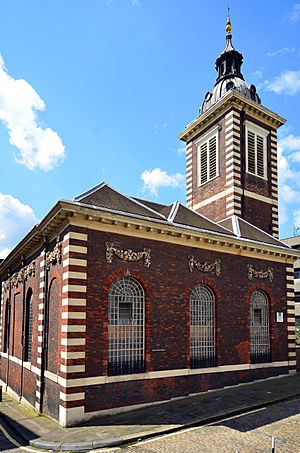St Benet's, Paul's Wharf facts for kids
Quick facts for kids St Benet Paul's Wharf |
|
|---|---|
 |
|
| 51°30′42.01″N 0°5′57.38″W / 51.5116694°N 0.0992722°W | |
| Location | London, EC4 |
| Denomination | Anglican |
| Previous denomination | Roman Catholicism |
| Churchmanship | Conservative evangelical |
| Architecture | |
| Heritage designation | Grade I listed building |
| Architect(s) | Christopher Wren, possibly Robert Hooke |
| Style | Baroque |
| Completed | 1683 |
| Specifications | |
| Height | 115 ft (35 m) |
| Administration | |
| Diocese | London |
The Church of St Benet Paul's Wharf is a special Welsh Anglican church in the City of London, England. Since 1556, it has also been the official church for the College of Arms. This is where many officers of arms (people who deal with coats of arms and family history) have been buried over the years.
In 1666, a huge fire called the Great Fire of London destroyed the church. It was then rebuilt and joined with another nearby church, St Peter's. The famous architect Sir Christopher Wren designed the church you see today. It's one of only four churches in the City of London that wasn't damaged during World War II.
Contents
A Look Back at St Benet's History
St Benet's has a very long history, going all the way back to the year 1111. That's when the first church was built on this spot. It was named after St Benedict. Over time, people started calling it St. Benet's Paul's Wharf because of where it was located near the river.
To the west of the church was a watergate for Baynard's Castle. Both the church and the castle were destroyed in the terrible Great Fire of London in 1666. Sir Christopher Wren, a very famous architect, redesigned the church. It opened again in 1683. The builder for this project was Edward Strong the Elder.
In 1879, the church was almost closed down. But its supporters worked hard to save it. Queen Victoria then decided that the church should be used by Welsh Anglicans for their services. Today, St Benet's is still London's main Welsh church. Services are held in the Welsh language, with English translations available.
St Benet's Church Today
In 2008, the church was closed for a few months because not many people were attending. But it reopened in December that year for the Christmas carol service.
Today, services are held every Sunday morning at 11 am. Sometimes, there are special services on Sunday afternoons at 3 pm. If you want to visit, you can tour the church on Thursdays between 11 am and 3 pm.
The church follows a Conservative Evangelical style of worship within the Church of England. This means it has made decisions to not allow women to be ordained as priests or to hold leadership roles.
Outside the Church
The church is built with dark red bricks. It also has alternating layers of Portland stone at its corners. The tower is on the north-west side of the main church building. It has a small lead dome on top, with a lantern and a simple, short spire.
Inside the Church
The inside of the church is almost square-shaped. It's quite unusual for a Wren church because its ceiling is flat, not domed or curved. The north gallery used to be for the Doctors' Commons, but now the College of Arms uses it.
Most of the church's original furniture from the 1600s is still there. This includes the beautiful altar table, the reredos (a screen behind the altar), and the pulpit. These were all designed by Grinling Gibbons, a famous wood carver. The lectern (where readings are given) and the baptismal font (for baptisms) are also original.
The galleries inside the church are held up by Corinthian columns, which have fancy tops. There is also a memorial to Inigo Jones, a famous architect who was buried in the old church building. You can also see a medallion bust (a sculpture of a head and shoulders) of Sir Robert Wyseman, who helped the church financially and died in 1684.
Important People Buried Here
Many important officers of arms from the College of Arms have been buried at St Benet's. These are people who held special roles related to heraldry (coats of arms and family history). Some of them include:
- Hon. Sir George Rothe Bellew, a Garter
- Sir Ralph Bigland, Garter
- Sir Anthony Richard Wagner, Garter
- Sir Gilbert Dethick, Garter
- Sir Henry St George, Garter
- John Riddell Bromhead Walker, a Clarenceux
- George Drewry Squibb, a Norfolk
- Rodney Onslow Dennys, a Somerset
- Major Francis Jones, a Wales
- John Philipot, Somerset
- John Charles Brooke, Somerset
- Sir William Cheney, Kent
See also


